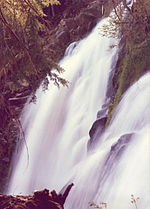AY Honors/Waterfalls/Answer Key
A waterfall is usually a geological formation resulting from water, often in the form of a stream, flowing over an erosion-resistant rock formation that forms a sudden break in elevation. Waterfalls may also be artificial, and they are sometimes used for garden and landscape ornament.
Some waterfalls form in montane environments where erosion is rapid and stream courses may be subject to sudden and catastrophic change. In such cases, the waterfall may not be the end product of many years of water action over a region, but rather the result of relatively sudden geological processes such as thrust faults or volcanic action.
Formation
Some of waterfalls are the result of action of water on the underlying strata. Typically, a stream will flow across an area of formations, and more resistant rock strata will form shelves across the streamway, elevated above the further stream bed when the less erosion-resistant rock around it disappears. Over a period of years, the edges of this shelf will gradually break away and the waterfall will steadily move upstream. Often, the rock strata just below the more resistant shelf will be of a softer type, and will erode out to form a shallow cave-like formation known as a rock shelter (also known as a rock house) under and behind the waterfall.
Streams often become wider and more shallow just above waterfalls due to flowing over the rock shelf, and there is usually a deep pool just below the waterfall due to the kinetic energy of the water hitting the bottom.
Waterfalls are a hindrance to river transportation, and so the Welland Canal was built in 1829 to allow ships to pass Niagara Falls in the Great Lakes.
Types of waterfalls
Certain terms describe several common types of waterfalls:
- Block, where the water descends from a relatively wide stream or river;
- Cascade, where the water descends a series of rock steps;
- Cataract, where the waterfall is large;
- Fan, where the water spreads horizontally as it descends while remaining in contact with bedrock;
- Horsetail, where descending water maintains some contact with bedrock;
- Plunge, where the water descends vertically, losing contact with the bedrock surface;
- Punchbowl, where the water descends in a constricted form, then spreads out in a wider pool;
- Segmented, where distinctly separate flows of water form as it descends; and
- Tiered, where water drops in a series of distinct steps or falls.
Examples of large waterfalls
A partial list of waterfalls is available; the world's largest waterfalls include:
- South America's Angel Falls, the world's highest at 979 m (3230 ft), in Venezuela ;
- Africa's Victoria Falls, the world's largest, on the Zambezi River;
- Africa's Boyoma Falls, with the world's highest volume, 17,000 m³/s (600,000 ft³/s), on the Congo River;
- Yosemite Falls, the tallest in North America, located in Yosemite National Park;
- Niagara Falls, most voluminous in North America, on the border between the USA and Canada;
- Rhine Falls, Europe's largest, located in Switzerland.
- Jog Falls, India's highest and second highest in Asia, located in Karnataka state,India;
External links
de:Wasserfall eo:Akvofalo es:Cataratas et:Juga he:מפל מים it:Cascata ja:滝 nl:Waterval pl:Wodospad pt:Cachoeira (cascata) sl:Slap sv:vattenfall



